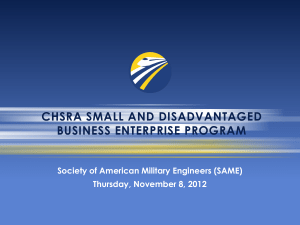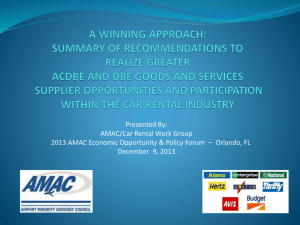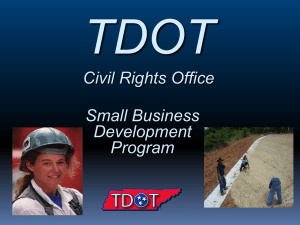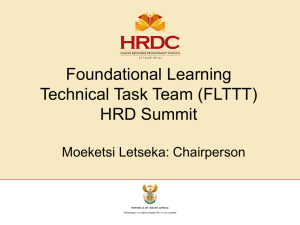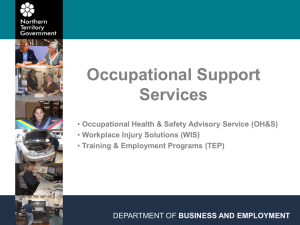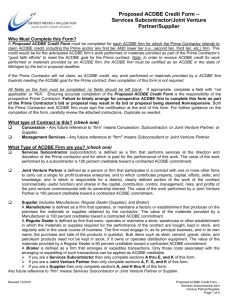AMAC Industry Day Preview 2014
advertisement
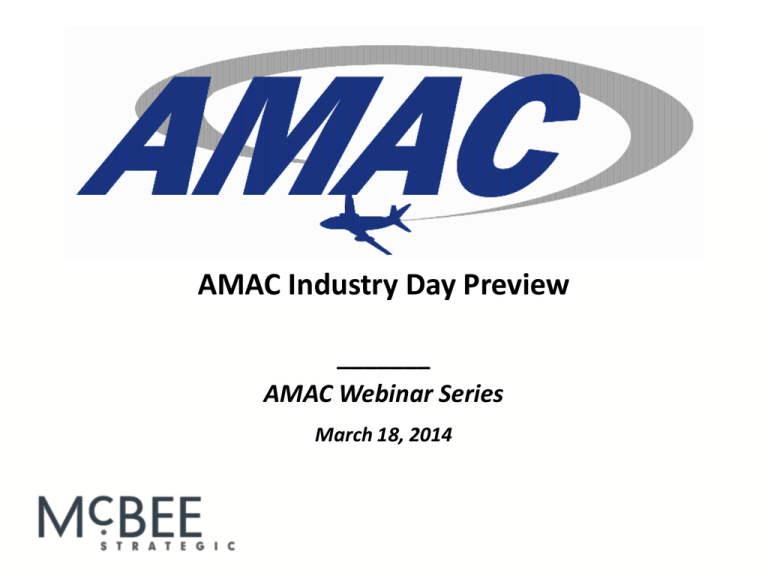
AMAC Industry Day Preview _______ AMAC Webinar Series March 18, 2014 AMAC’s Industry Day on Capitol Hill When: Tuesday, April 1, 2014 Where: The Reserve Officers Association Building on Capitol Hill in Washington, DC Why: Forum to Engage with and Educate Policymakers Explain AMAC’s Priorities, Protect Current Programs, and Expand Federal Contracting Opportunities for AMAC’s Membership Format: Morning Sessions with Policy Panels/Speakers from Capitol Hill and the Administration Afternoon Meetings in Congress 2 Agenda 1. AMAC Legislative Agenda 2. Lobbying 101 3. Political Outlook in Congress 3 AMAC Legislative Priorities Top Priorities for Industry Day Continue to Expand AMAC’s Profile on Capitol Hill Expand Business Opportunities Protect Existing Opportunities Educate on Threats to the Program Request FAA to Fully Assess Benefits of the DBE/ACDBE Programs and Potential Impacts of Funding Shifts Introduce the Rental Car Policy Proposal Seek Opportunities at TSA Work with Airport Community to Push for More Opportunities Locally 4 AMAC Legislative Priorities Who Are We Meeting With? Congressional committees of jurisdiction AMAC membership’s congressional representation Congressional caucus leaders Why These Offices? Oversight and control over aviation and M/W/DBE issues Offices that represent AMAC members have a stake in our issues Caucus leaders can spread our message to a large group of congressional members 5 Build AMAC’s Brand Key Highlights AMAC is the only national, non-profit trade association dedicated to promoting: The full participation of minority-owned, women-owned and disadvantaged business enterprises (M/W/DBEs) in airport contracting; and The inclusion of minorities and women in employment. AMAC and its affiliates include airport operators, government officials, corporations, and M/W/DBE entrepreneurs. Since its inception, AMAC has been at the forefront of nearly every national policy initiative impacting the participation of disadvantaged businesses in airport contracting. Messaging Points Supports Local Jobs Supports Local Development Supports Our Communities 6 Protect the DBE/ACDBE Programs The FAA’s DBE/ACDBE Program Airport agencies receiving financial assistance from the Federal Aviation Administration (FAA) are required to establish goals for the participation of minority-owned, women-owned and disadvantaged business enterprises (M/W/DBEs) Annual M/W/DBE Contracting Goals Subcontracting Goals Certification of M/W/DBE Firms Statutory 10% Aspirational Requirement for Federally Allocated Funds Annual M/W/DBE Contracting Goals This includes airport funding from the FAA’s Airport Improvement Program (AIP) This DOES NOT including airport funding received through federally authorized passenger facility charges (PFCs) 7 Protect the DBE/ACDBE Programs Current Status: Two Major Federal Programs The Airport Improvement Program (AIP) ($3.2 billion) The Passenger Facility Charge (PFC) Program ($2.8 billion) Dollars in Millions AIP vs. PFC Funding Streams $8,000 70.00% $7,000 60.00% $6,000 50.00% $5,000 $4,000 40.00% AIP Authorized AIP Allocated 30.00% PFCs Allocated $2,000 20.00% Total Allocated $1,000 10.00% $3,000 $0 Percent AIP 0.00% 8 Why Is This Important? Downward Pressure on Federal AIP Monies Airport Infrastructure Needs More, Not Less, Funding The Administration and Large Airports Have Proposed PFC Increases in Exchange for Cuts to AIP Cuts to AIP = Cuts to M/W/DBE Opportunities AMAC Supports Increases to PFCs But, Airport Infrastructure Funding Must Continue to Recognize the Role of M/W/DBEs Increases Must be Tied to the Expansion of M/W/DBE Requirements to PFC Funding Streams 9 Protect the DBE/ACDBE Programs President’s FY15 Budget Proposes cuts to AIP (M/W/DBE Reqs.) Cuts are to be made up by increases to PFCs (No M/W/DBE Reqs.) Our Response Educate Congress on the negative effects of such a funding shift Organize a letter from Congress expressing concern and urging the FAA to conduct an economic impact study Grassroots outreach to policymakers urging their support for the expansion of M/W/DBE protections This will: Let the Administration know that M/W/DBE protections must be continued Build a data-driven base of support for the importance of the DBE and ACDBE programs 10 Rental Car Policy Proposal The Problem: Key aspects of the ACDBE/DBE rules undercut the ability of airport agencies and car rental firms to find and work with firms who can meet current certification standards and who can provide goods and services on the scale dictated by the unique aspects of car rental purchasing. The Answer: AMAC and car rental industry reunited for new thinking to effectively address the issue. Together, a Policy Proposal has been created to: Implement new regional ACDBE contract goals / maintain 10% national and local ACDBE annual contract goals Mandate uniform ACDBE goal-setting methodology Modify ACDBE certification standards Modify counting rules Establish uniform reporting format and schedule for car rental companies to report ACDBE and DBE participation to airports / airports obligations remain unchanged This Policy Proposal will be presented to the Administration but we want to 11 educate and ensure the support of congressional allies Lobbying 101 Introductions: The Team Leader should begin by introducing him or herself and AMAC as an organization. Following the introduction of AMAC, the Team Leader should invite the members of the AMAC team in attendance to introduce themselves. All Politics is Local: If you are a constituent or do business in the district of the office you are meeting with, make mention of this as you introduce yourself. Always Remember: Meetings with staffers can often be just as important, if not more important, than Member meetings. Staff are often the ones making policy recommendations and guiding decisions for the Members. 12 Lobbying 101 Team Leader / Team Member Roles The Team Leader should feel free to delegate any of these responsibilities to specific Team Members Team Leaders Can: Initiate the introductions Briefly describe AMAC Outline our legislative priorities Document any follow up Team Members Should: Introduce themselves and briefly describe their work Offer information and context on the importance of AMAC’s legislative priorities in operating their businesses on a daily, monthly, and annual basis 13 Lobbying 101 Format of Each Meeting Assume that each meeting will not last longer than 30 minutes The up front messaging should be limited to no more than 10 minutes to enable dialogue and questions to follow Messaging Communicate in a way that allows for input from other members of the team, and provides the opportunity for Members or staff to interject questions in the dialogue Being concise is helpful in getting the message across If you don’t know the answer to something or need to double check the facts, offer to follow-up 14 Political Landscape Republican House – Democratic Senate Election Year! Members of Congress are extra cautious Partisanship FAA Reauthorization is Coming Up Current bill expires end of FY15 Tax Reform Continues to be Discussed No concrete path forward at this juncture 15 In Summary Have Fun! Be Conversational! Introduce AMAC and your Organization Touch on AMAC’s Priorities Continue to Expand AMAC’s Profile on Capitol Hill Expand Business Opportunities Protect Existing Opportunities Educate on Threats to the Program Request FAA to Fully Assess Benefits of the DBE/ACDBE Programs and Potential Impacts of Funding Shifts Introduce the Rental Car Policy Proposal Seek Opportunities at TSA Work with Airport Community to Push for More Opportunities Locally 16 Questions? 17
